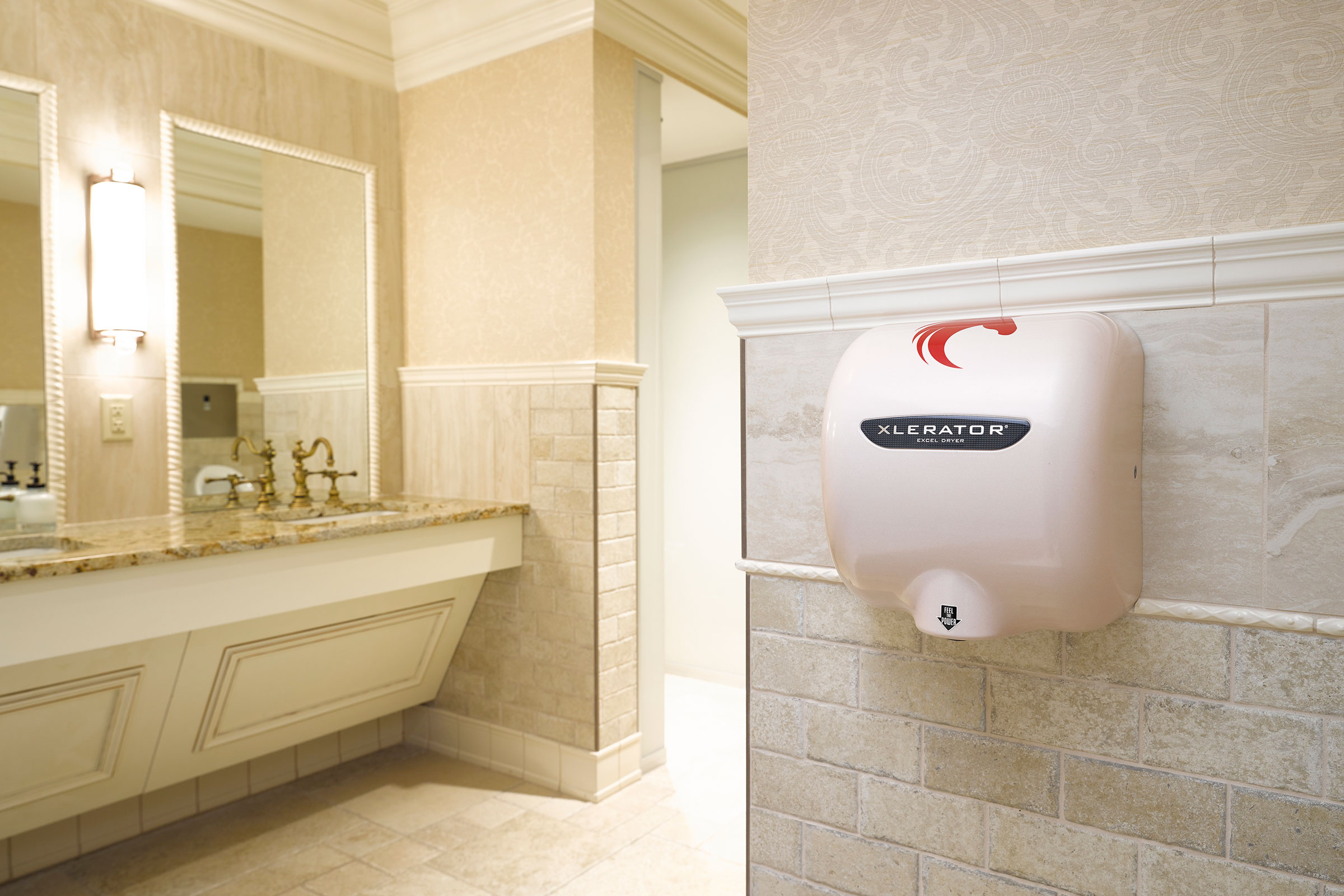Story at a glance:
- Universal design solutions are showing up more in both residential and public projects.
- The population’s life expectancy is anticipated to increase by eight years by 2050.
- Implementing universal design can add aesthetic design elements to spaces as well as function.
By 2050 life expectancy is projected to increase from 68 to 76 years old, according to the NIH. The Annual Disability Statistics Compendium found in 2019 that 13.2% of people in the US—approximately 43,227,000 people—had disabilities.
The projected increase in life expectancy and the number of people with disabilities means the built environment needs to be as accessible as possible. Universal design can improve the experience of all people in both public and residential spaces, and products designed for specific target groups can sometimes generate interest and demand from unforeseen markets. OXO Good Grips and their various case studies show how specialized product design—originally made with people with arthritis in mind—can generate widespread demand.
This article explores some universal design products that can be used in residential and commercial spaces.
What is Universal Design?
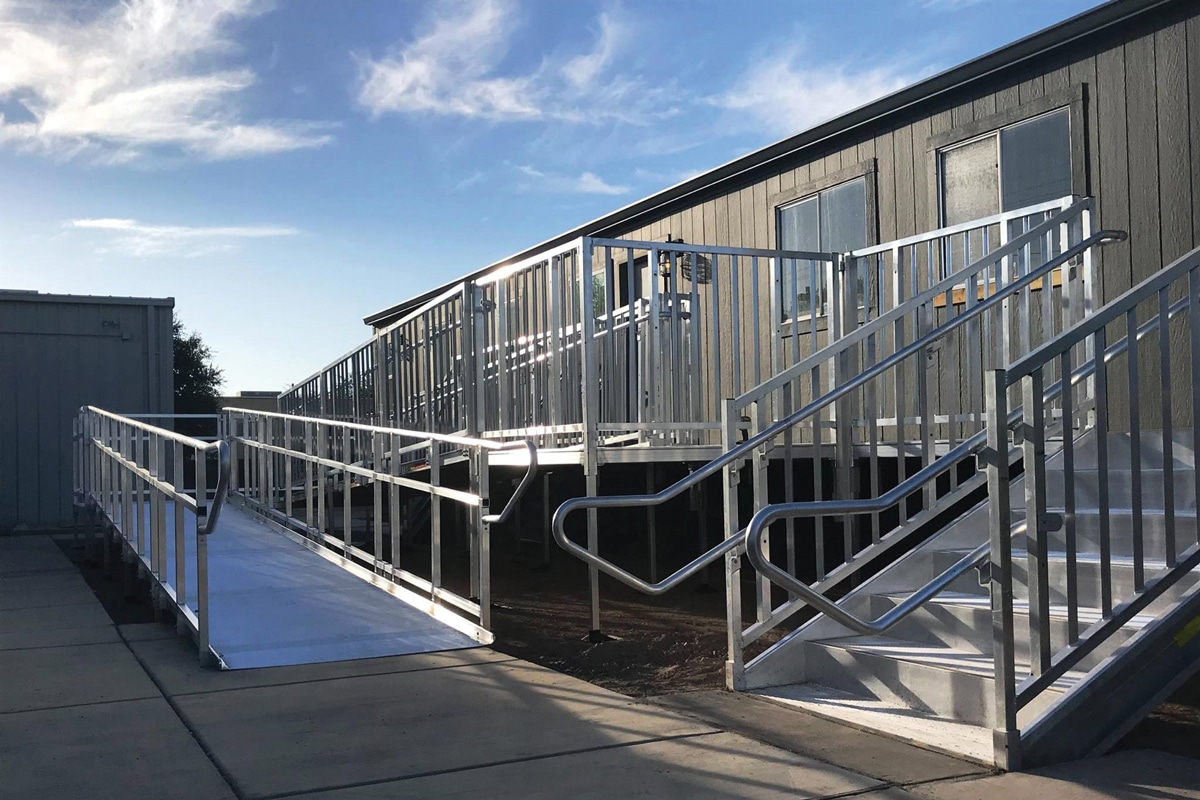
Universal design aims to create products and environments that are usable by all people without the need for specialized design or adaptations. Photo courtesy of EZ-Access
Let’s first talk a bit about what universal design is and isn’t.
Architect Ronald Mace is known for coining the term universal design in 1985 and for his work advocating for people with disabilities.
Mace originally defined universal design as “design that’s usable by all people, to the greatest extent possible, without the need for adaptation or specialized design.”
7 Principles of Universal Design
In 1997 the Center for Universal Design at North Carolina State University identified seven core principles as being foundational to successful universal design:
- Equitable use. The design is both useful and marketable to people with diverse abilities (as opposed to being designed with a single group of people in mind).
- Flexibility in use. The design is capable of accommodating a wide variety of individual abilities and preferences.
- Simple and intuitive use. Use of the design is both easy and intuitive to understand, regardless of the user’s knowledge, experience, language skills, or current concentration level.
- Perceptible information. Any necessary information regarding the design’s use or operation is communicated effectively to the user, regardless of the user’s sensory abilities or ambient conditions.
- Tolerance for error. The design is capable of tolerating error and minimizing the adverse consequences of unintended or accidental actions.
- Low physical effort. The design or product can be used comfortably, efficiently, and with minimal fatigue regardless of an individual’s age, physical ability, or mental ability.
- Size and space for approach and use. Adequate size and space is provided for approach, reach, manipulation, and use regardless of the user’s mobility, body size, or posture.
Evolution of Universal Design

Ensuring all community members have equitable and seamless access to enjoy public spaces is at the core of universal design. Photo courtesy of Sizemore Group
Universal design has been widely embraced across the industry since Mace coined the term in 1985. This can be seen at trade associations like the National Association of Home Builders, which offers a variety of accessibility certifications, as well as at newer organizations like the Living in Place Institute.
The inherent alignment of universal design with sustainability has also cemented it as an integral component of the green building movement. “Designing for longevity means creating environments that serve generations without requiring significant modifications,” Lily Berrios, president of Sizemore Group—a full-service design studio—previously wrote for gb&d.
“Combining universal design with sustainable practices creates spaces that are inclusive, future-proof, and environmentally responsible. By designing for people of all abilities—and for the long term—you can enhance lives, foster community engagement, and stand as models of thoughtful, forward-thinking design.”
Universal Design vs Inclusive Design vs Accessible Design
In the built environment universal design often overlaps with both inclusive and accessible design, though each is unique:
- Universal design. Aims to create a single design solution that may be accessed and used by as many people as possible, without need for adaptations or specialized design strategies; universal design has its origins in architecture and is best suited to buildings and other tangible or environmental contexts.
- Inclusive design. Looks to create products, services, and environments that understand and enable people of all demographic backgrounds and abilities; rather than take a one-size-fits-all approach, inclusive design recognizes that one-size-fits-one solutions are often necessary.
- Accessible design. Is concerned exclusively with making buildings, interfaces, and other technologies usable to people with disabilities (including physical, visual, auditory, and cognitive disabilities); accessible design has a narrower scope than either universal or inclusive design as it is focused on ensuring specific accommodations are met.
10 Products for Universal Design
Now that we’ve a better understanding of what universal design is, let’s take a look at a few products that have been designed to be used by everyone:
1. Task Lighting & Rocker Switches
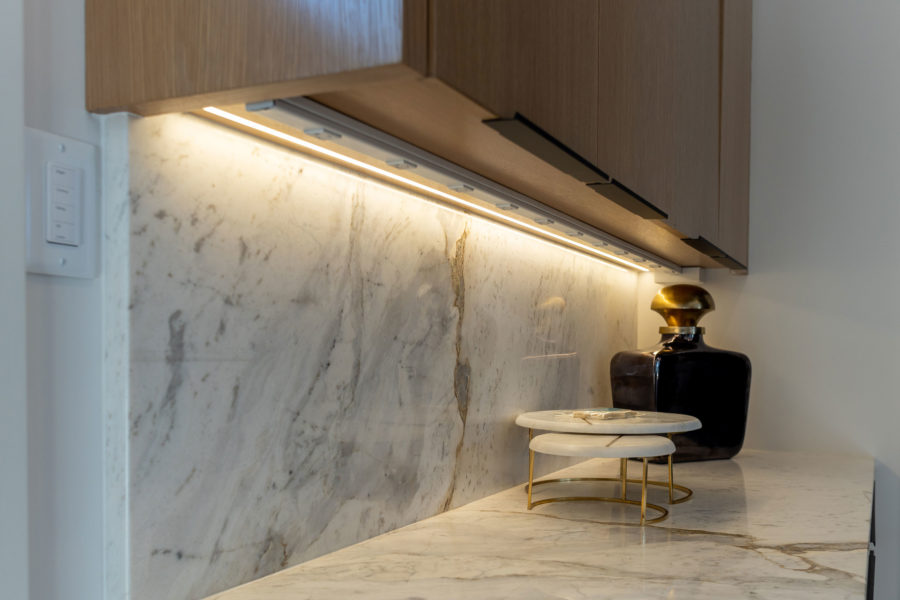
Task lighting—like this under-cabinet mounted 3000K COB Tape Light from American Lighting—improves visibility and makes performing various actions easier and safer. Photo courtesy of American Lighting
As the name suggests, task lighting refers to those light fixtures designed to illuminate specific areas where users are performing tasks—such as kitchen countertops, sinks, desks, and the like—while simultaneously improving contrast to better visibility.
Task lighting is especially useful for those with partial blindness and/or other visual impairments (such as glaucoma, macular degeneration, cataracts, and the like), but it ultimately helps all users by ensuring that surfaces are adequately lit, reducing the likelihood of accidents and injuries.
Task lighting is most often found in residential applications but can also be useful in offices, hospitality venues, and other commercial settings. Innovations in modern LED technology have expanded the possibilities of task lighting, allowing designers to ensure that lighting is exactly where it needs to be. Attaching LED light strips—like those from American Lighting—underneath cabinets, for example, can be a great way to illuminate countertops that do not receive enough light from overhead fixtures.
Care should be exercised when choosing lighting controls to further improve the overall accessibility of task lighting. Rocker switches, for example, are preferable to traditional toggle switches that flip up and down as they have broader, flatter surfaces and only require the user to press on the top or bottom to turn the light on or off. This effectively eliminates any need for grip strength and greatly reduces the amount of precision required to operate the switch, making them much easier to use in general, but especially for those with arthritis or limited strength/dexterity in their hands, as well as persons with varying degrees of lower-arm amputations.
However, all light switches should be positioned at an appropriate height so as to be easily operated by children, persons of short stature, and those in wheelchairs or other motorized mobility devices.
2. Slip-Resistant Flooring & Finishes
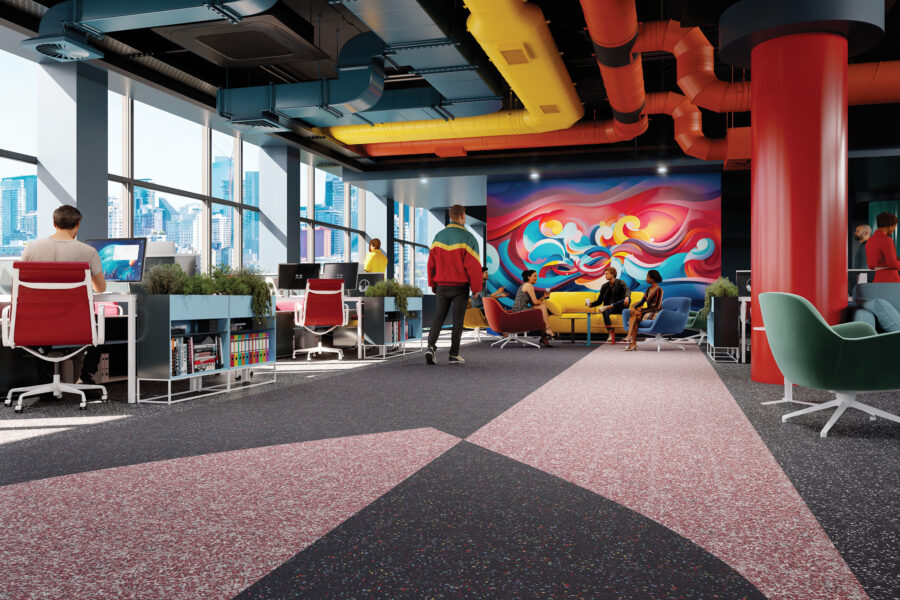
Rubber flooring is naturally slip-resistant and helps make buildings safer, easier, and more comfortable to traverse for everyone. Photo courtesy of REGUPOL
Flooring is the single-most used component of any building or public space, and it’s extremely important that all people can safely and conveniently traverse it regardless of whether they’re walking unaided or with the help of a mobility device, no matter if the surface is dry or wet.
Specifying slip-resistant materials and floor finishes are some of the most effective ways to ensure that flooring remains universally accessible. Rubber flooring, for example, is slip-resistant by nature thanks to its high coefficient of friction, a quality that makes rubber less slippery, even when wet, than materials like linoleum, vinyl, and porcelain tile. What’s more, many rubber flooring manufacturers—like REGUPOL, for one—prioritize using recycled rubber in their products, which typically has a higher slip resistance than new rubber.
If necessary, rubber flooring can be made even more slip-resistant by adding textured surfaces (e.g. grips, ridges, and ribs) or drain holes, the latter of which helps keep water from pooling in the first place. It is important to choose textured surfaces that are not too tall and whose patterns are not spaced too far apart, as such characteristics may actually pose a tripping hazard and hinder the use of canes, walkers, or other mobility aids.
In addition to being slip-resistant, rubber also has the advantage of being a naturally soft material, meaning it is more comfortable to walk and stand on for long periods of time while simultaneously reducing the risk of serious injury should a person trip or fall. “From a safety standpoint, having a slip-resistant floor takes the liability off the end user and the client,” Bill Neifert, commercial sales director at REGUPOL, previously told gb&d.
And while rubber flooring may conjure up images of gyms and sports facilities, the reality is that rubber is an extremely versatile flooring solution, found everywhere from airports and hospitals to schools and hospitality venues. “Rubber flooring can go more places than it can’t,” says Neifert. “I learn more from designers on where it can go and what they’re trying to do because someone’s always finding a unique application for it.”
REGUPOL’s Revolution line of rolled rubber flooring, for example, is available in a wide range of colors, patterns, and textures designed to complement modern aesthetic preferences. “What I’m trying to do is make this a rubber carpet, rubber terrazzo, rubber stone—show that you can get those looks with rubber flooring, but you’re also going to get benefits from a durability standpoint; from a quiet, comfortable, and slip-resistant standpoint; from a safety standpoint,” Neifert says. “And to top it all off you get the environmental aspect of having post-consumer and post-industrial waste in a flooring product.”
3. Access Ramps
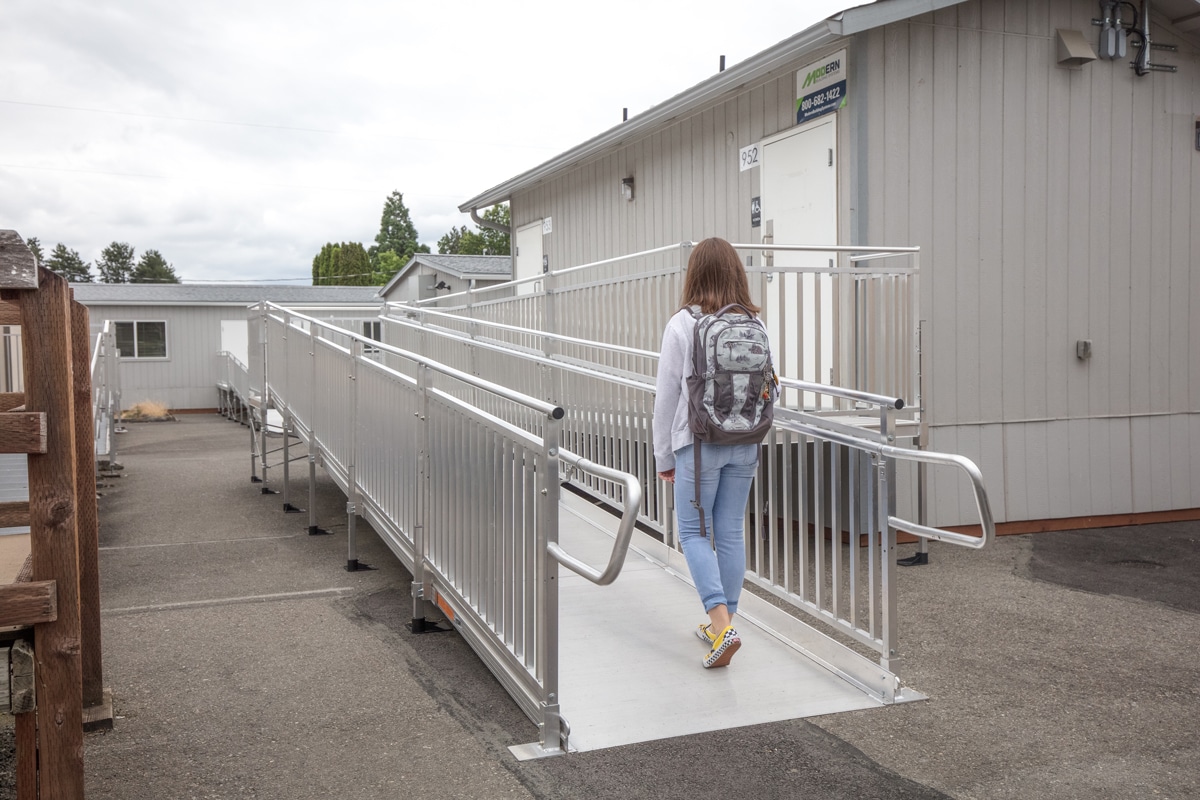
At this growing high school, EZ-ACCESS replaced deteriorating wood ramps for a number of existing portable classrooms, as well as designed a series of ramp, step, and platform systems for their new portable classrooms. Photo courtesy of EZ-ACCESS
As the quintessential example of universal design, ramps—and by extension, curb cuts—have long served as remedies to the inherent limitations posed by stairs in the built environment. Ramps are also one of the most common examples of accessible design, with the ADA requiring ramps and curb ramps be installed along all accessible routes spanning level changes greater than half-inch.
For a ramp run to be ADA compliant, it must:
- Possess a uniform slope that does not exceed a 1:12 ratio
- Possess a uniform cross-slope that does not exceed a 1:48 ratio
- Feature a clear width of at least 36” between the leading edge of handrails (if applicable)
- Include handrails on both sides (if the rise is greater than 6 inches)
- Not exceed a 30-inch rise per run
- Feature firm, stable, and slip-resistant surfaces on both the run and landing surfaces
- Have level landings at both the top and bottom of each run (intermediate landings between runs must be at least 60 inches
- wide clear and 60-inch long clear where ramps change directions)
- Include edge protection along the ramp run and landings
EZ-ACCESS is a leading provider of ramps and other access solutions for commercial, industrial, residential, and recreational spaces. EZ-ACCESS’ PATHWAY HD Code Compliant Modular Access System meets all ADA requirements as well as IBC, OSHA, and most local code guidelines. PATHWAY HD is constructed from high-quality corrosion-resistant aluminum and features slip-resistant Gecko Grip raised-rib tread to ensure safe use in all weather conditions.
“EZ-ACCESS Modular Access Systems have a permanent, slip-resistant surface and smooth, continuous handrails for safe traversing in all weather conditions,” Mike Johnson, national vice president of commercial and industrial sales at EZ-ACCESS, previously wrote for gb&d. “They provide maximum stability by utilizing their own base rather than being buried into the ground.”
And while wheelchair users are often cited as the main beneficiaries of ramps and curb cuts, those using walkers, canes, crutches, and other permanent/temporary mobility aids benefit as well, as does anyone maneuvering a stroller, hand trolley, or other wheeled device—or anyone who’s ever tripped over a step, for that matter.
4. Automatic Doors & Door Operators
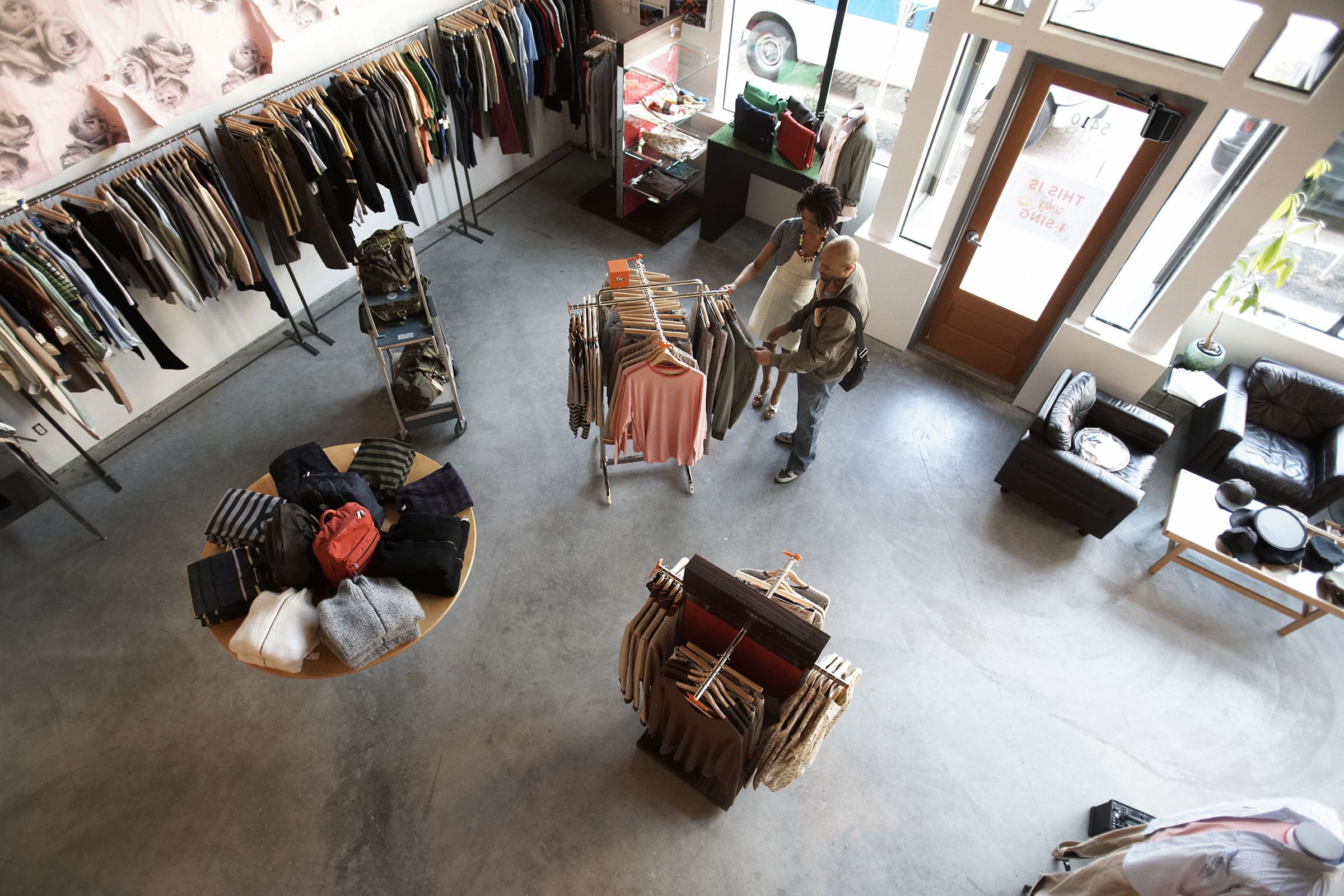
Automatic doors and door operators—like the ADAEZ from ASSA ABLOY—are quintessential components of universal design. Photo courtesy of ASSA ABLOY
After stairs, traditional pull-handle and turn-knob doors are the second-most common barriers to achieving universal access in the built environment. Not only do these pose an inconvenience to persons with wheelchairs, walkers, and other mobility devices, but also people with strollers or hand trucks, individuals who are carrying something in both hands, persons with limited mobility in their hands/wrists/arms, et cetera.
In recent years many of these doors—at least in public spaces—have been replaced with automatic sliding doors that open when their sensors detect movement, greatly improving overall accessibility and ease of building use.
It may not be possible to replace every door with automatic sliding doors, especially when it comes to retrofits, renovations, and preservation projects. In these instances it may make more sense to install an automatic door operator—a device that opens a swing-door at the press of a push-plate, holds it, and then closes it after a set amount of time has passed.
ASSA ABLOY is a global leader in both mechanical and digital access solutions, including low-energy automatic door operators like the 5800 Series ADAEZ model. Designed to be easily installed on most types of swing-doors, the ADAEZ supports both push- and pull-side mounting and features a regenerative drive battery that captures power created by manual operation of the door (though the company does offer models that can be plugged into a wall transformer). “When a person arrives at the door and requires the use of a push-button to open it automatically, the required electricity comes from that onboard battery instead of from the grid,” ASSA ABLOY’s Amy Musanti told gb&d in a previous article. “That push button can either be wired or, for even easier installation, triggered by radio frequency.”
In keeping with the philosophy of universal access, ASSA ABLOY intentionally designed the ADAEZ to be an affordable solution “Many of the customers who need this type of solution don’t have the most generous budgets,” writes Musanti. “We need to get away from this idea that a responsible building should cost more. The ADAEZ is meant to be an accessible and sustainable solution.”
5. Grab Bars
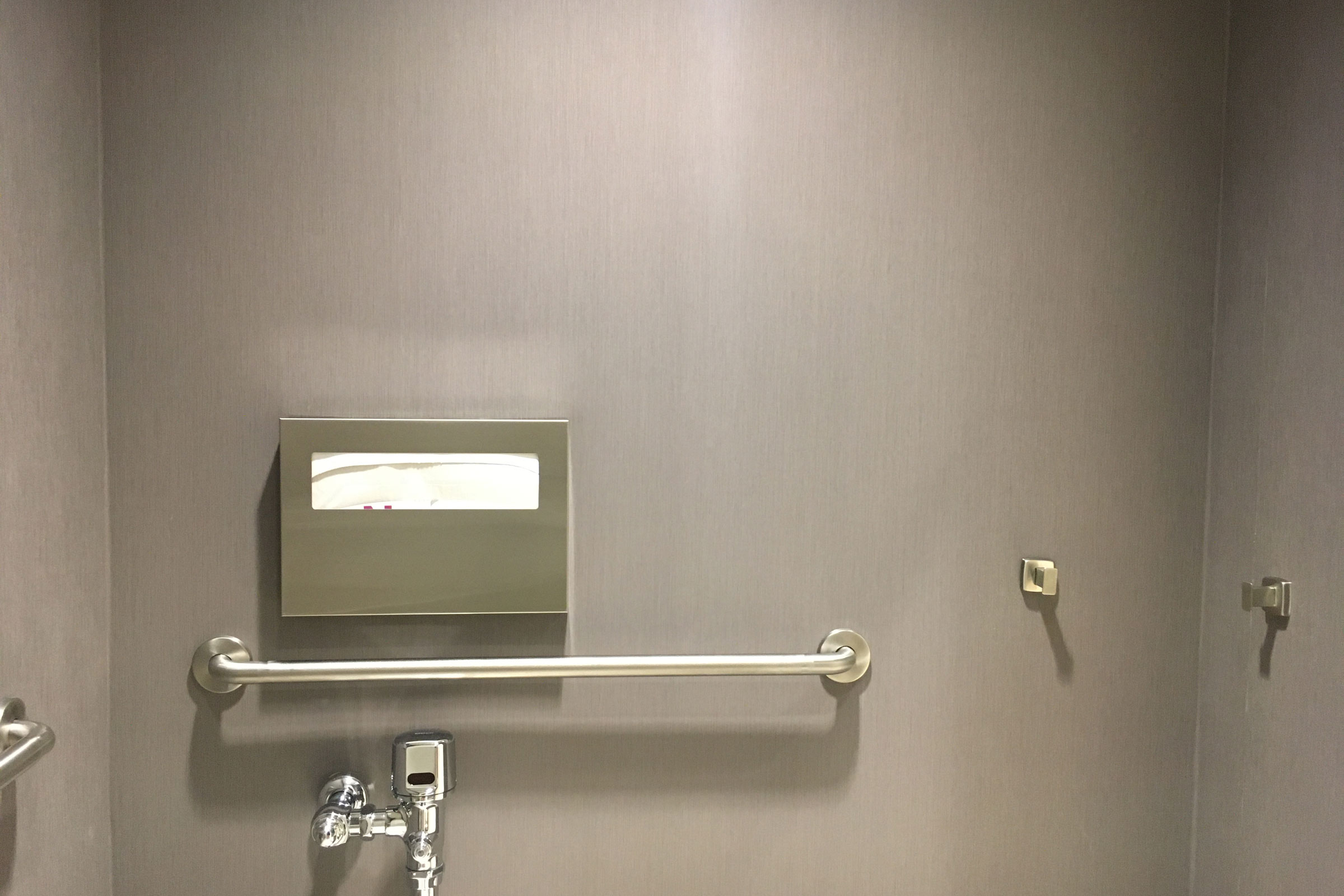
Dearborn grab bars are available in peened or satin finishes. Photo courtesy of Oatey Co.
Grab bars are another common example of universal design in the built environment, one that everyone is probably familiar with. Typically found in restrooms and shower stalls, grab bars are designed to help people with wheelchairs or other mobility devices get on and off toilets and into and out of the shower—though they realistically can provide stability and safety to any user.
Like ramps, grab bars installed in commercial or otherwise public settings are subject to certain ADA guidelines depending on their placement. Grab bars mounted on the side walls of toilet stalls, for instance, must be at least 42 inches long, located at maximum 12 inches from the rear wall, and extend at least 54 inches from the rear wall. Rear wall grab bars must be at least 36 inches long and extend at least 12 inches from the water closet’s centerline on one side and at least 24 inches on the other. The ADA’s requirements for grab bars mounted in shower stalls are a bit more in-depth.
Oatey Co. is a leading manufacturer and distributor of high-quality plumbing products and solutions, whose Dearborn brand includes a range of grab bars suitable for any project. “Dearborn Grab Bars are ADA-compliant and available in 1¼-inch and 1½-inch diameters with concealed or open flanges,” Evan Novak, senior manager of commercial sales at Oatey Co., previously wrote for gb&dPRO. “Available in peened or satin finishes, these grab bars can be ordered in whatever desired length is needed.”
6. Linear Drains
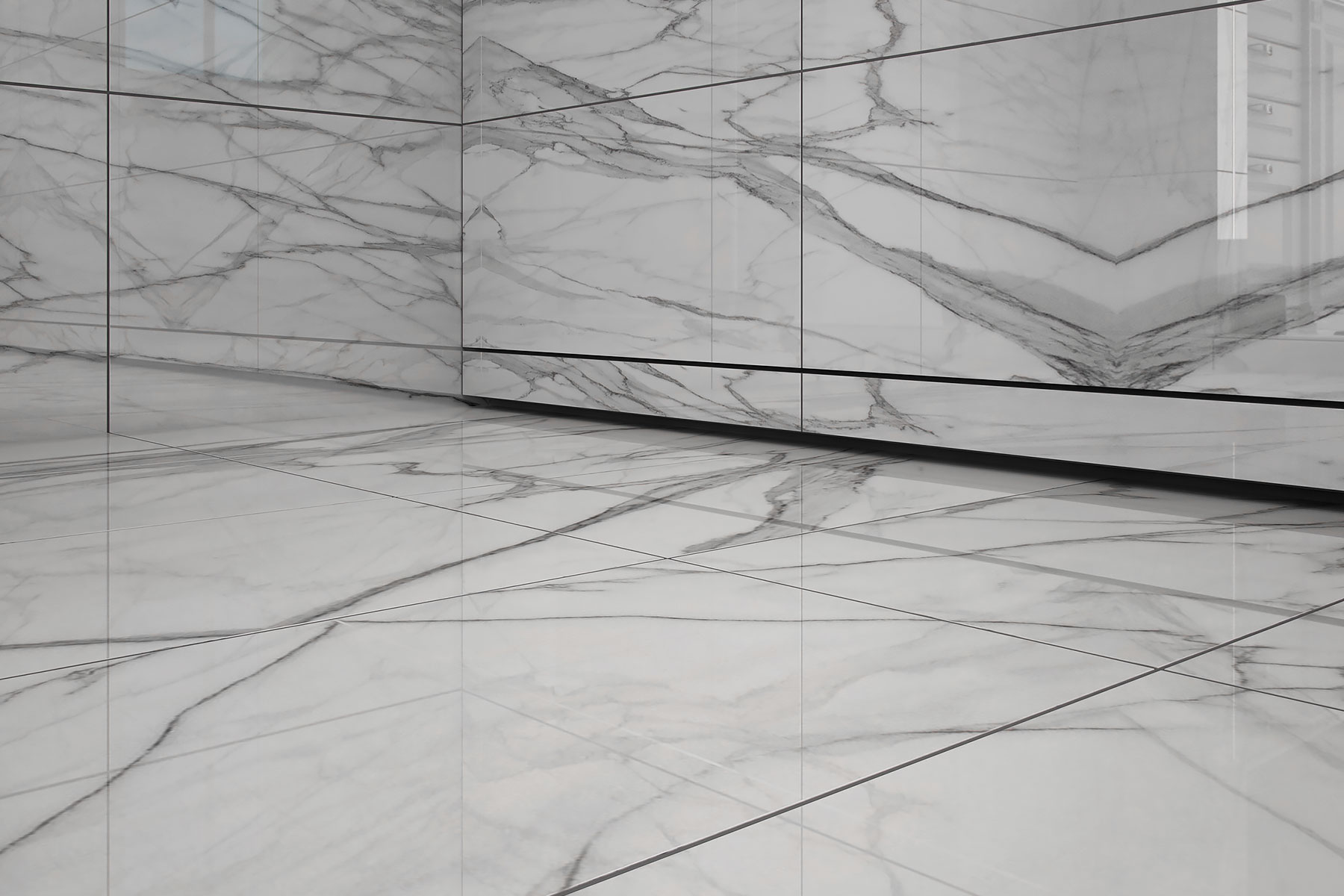
QuickDrain USA’s “invisible” linear drain, WallDrain, offers a cutting-edge design for ADA-compliant showers. Photo courtesy of Oatey Co.
Multigenerational households were on the rise during the pandemic, which rose to 15% between April and June 2020, according to the National Association of Realtors. To accommodate different generations in the home, products that support universal design are needed in bathrooms. One example of this can be found in linear drains.
“Linear drains used in curbless showers provide a universal design that appeals to multigenerational living conditions. Homeowners benefit any time safety measures can be taken into consideration within an upgraded bathroom design,” Marlee Gannon, director of wholesale product and channel at Oatey Co., told gb&d in a previous contribution. “Linear drains in curbless showers are the ideal design solution for creating ADA-compliant showers and wet spaces that are universally accessible. With no barrier to cross, the floor more easily accommodates a freestanding bench, a wheelchair, or other mobility aid.”
Oatey Co.’s linear drains are a prime example of products that can add to the overall look of a space, too. QuickDrain, an Oatey Co. brand, created the WallDrain that practically disappears into the wall, offering a sleek and contemporary look.
7. Nest Thermostat
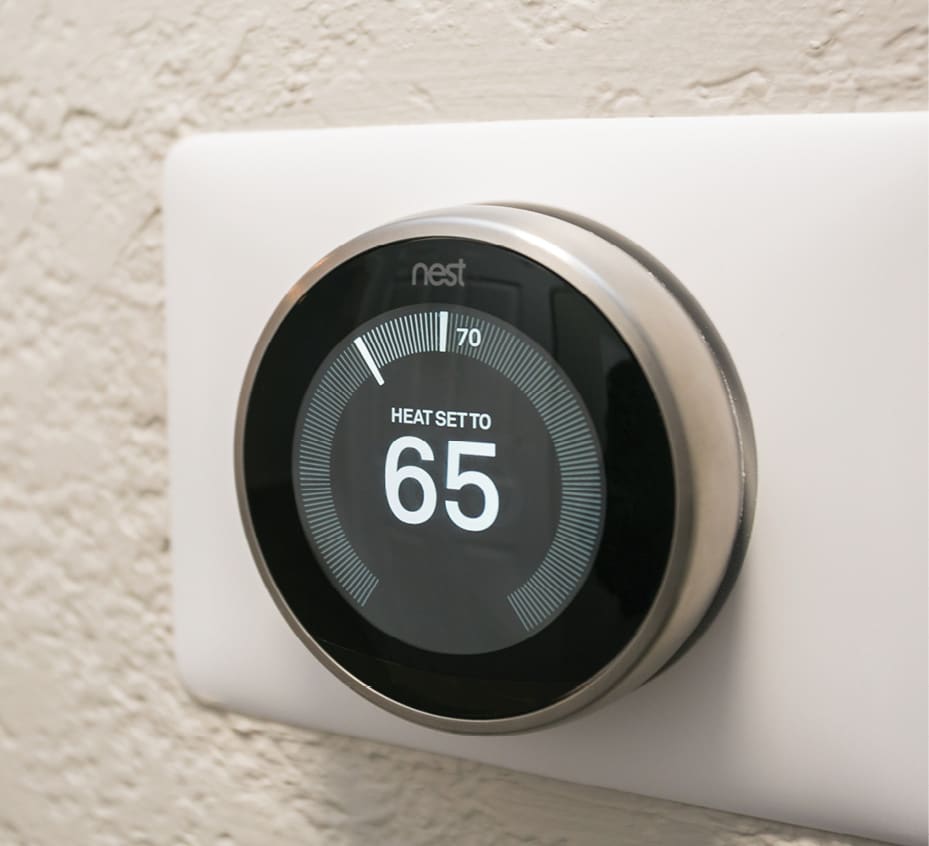
The Nest Thermostat is an example of how universal design can be implemented in assistive technology to help improve user independence. Photo courtesy of Nest
Although the physical layout of a home may be the first thing people think of when incorporating universal design, there are also several assistive technologies available. Assistive technology can help people to perform their daily tasks with more independence. “As technology advances, smart home intervention is becoming more and more popular to help people overcome barriers and enhance their quality of life,” Kaitlyn Richardson wrote for The Universal Design Project.
Many innovative devices on the market are able to improve the functionality and safety within a home, but one excellent example is the Nest Thermostat. When it comes to making heating and cooling your home accessible with smart home technology, Nest Thermostats are a product that works for the masses. Nest Thermostats are connected to the internet and can be controlled from anywhere using your smartphone—making it easier to access than a traditional thermostat.
Nest goes beyond that, as its software uses machine learning to understand your preferences and adjust accordingly. It uses motion sensors and can even use your phone’s GPS to determine if anybody is home, keeps track of the weather, and learns how long it takes for your home to be cooled or heated. “It’s always optimizing itself to meet your comfort demands and run the most efficient cycles,” Gene LaNois, general manager of the Professional Channel at Nest, previously told gb&d.
Nest also offers Wi-Fi security cameras and the Nest Protect smoke and carbon monoxide alarm, making it easier for owners to feel safe at home. Through the Works With Nest program, Nest devices are compatible with more than 170 products from other providers, from Google Home to Whirlpool appliances to Sleep Number beds.
8. Hand Dryers
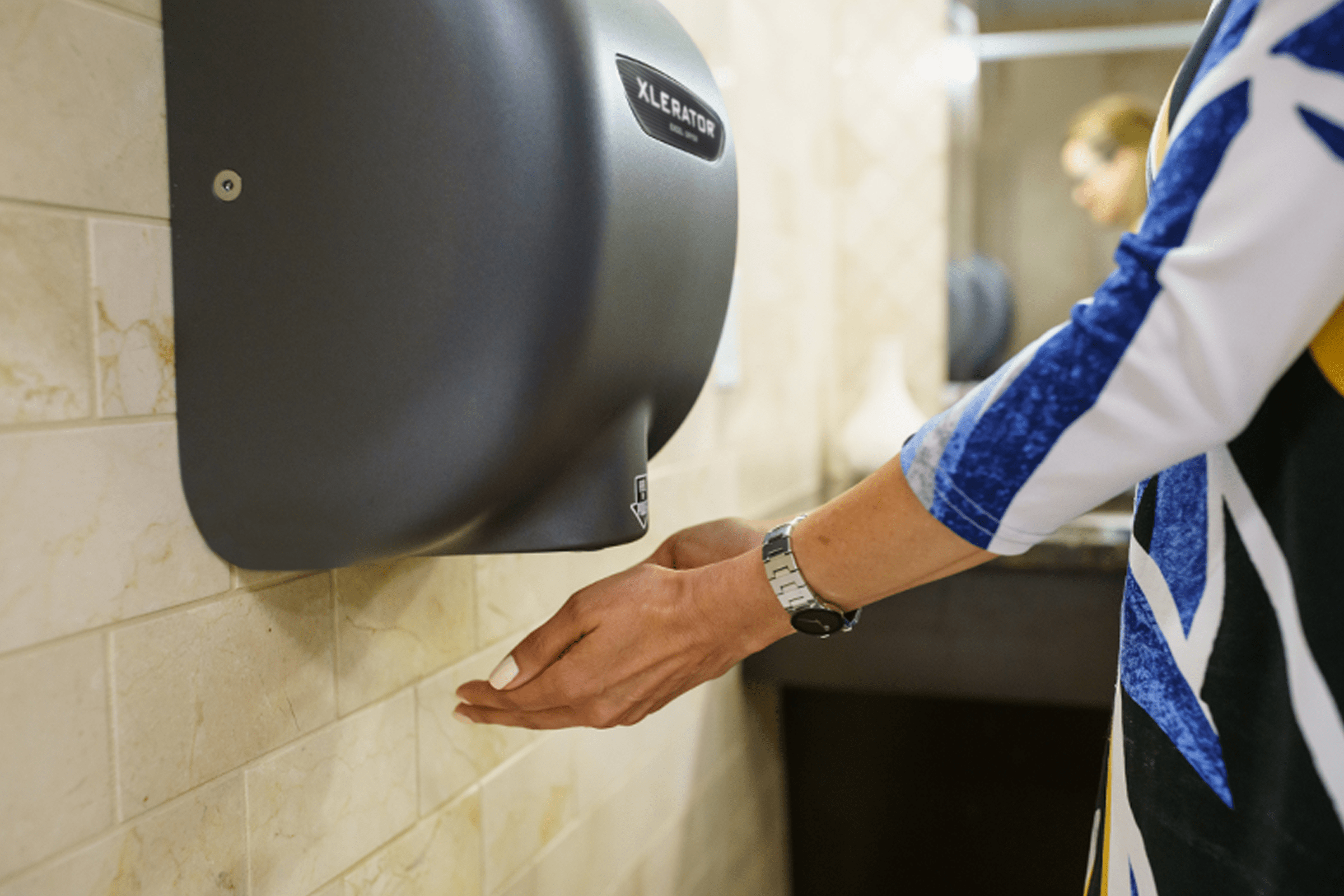
Hand dryers help promote a universal and hygienic restroom experience. Photo courtesy of Excel Dryer
Another restroom product that can support universal design, especially in public spaces, is hand dryers. Excel Dryer offers guidelines as well as several hand dryer models that meet ADA criteria. Excel Dryer also has the added benefit of offering some of most hygienic technology on the market.
“The hands-under style of our dryers makes them sensor-activated—that is, the motor is turned on, and the drying of hands begins once a user’s hands are placed below the hand dryer unit,” William Gagnon, vice president of marketing and sales at Excel Dryer, previously wrote for gb&d. “This is an effective hand drying option and helps to promote hand hygiene and create a more hygienic restroom experience. Air and water from hands are blown downward and away from users, as opposed to being captured in the unit, a problem encountered by trough-style dryers commonly referred to as ‘hands-in’ units.”
For a hand dryer to be ADA compliant, all buttons and touch-free sensors must fall between a height of 38 inches to 48 inches off the floor. Push buttons must be operable with one hand and should start the hand dryer with a force of no more than five pounds.
Hand dryers must be accessible for both right-handed and left-handed users. This allows for various wheelchair approaches in the bathroom, ensuring that every person can successfully dry their hands without a problem. Hand dryers also should be visibly different than surrounding materials and provide a certain length from the wall so the vision-impaired community can easily access the dryer. Excel’s ThinAir hand dryer is a prime example of products for universal design at work.
9. Acoustic Panels

Not only do the waves of Atmosphera® Swell by Arktura look great here at Iron Whale Asbury in Asbury Park, they are also made of SoftSound material to help absorb excess noise. Designed by TSG Design. Photo by Megan Lawrence
The World Health Organization estimates that by 2050 more than 700 million people—or one in every 10 people—will have disabling hearing loss. Universal design can accommodate people with varying hearing abilities through acoustic design.
Acoustic wellness is a key factor that contributes to overall health for all people. When the influence of external noise is reduced through sound insulation, distractions and masking sounds coming from outside are eliminated. Makers of acoustic products and panels like Arktura can help spaces capture sound better for everyone.
“Studies show prolonged exposure to distracting levels of sound range from tiredness, stress, to pain, and high blood pressure. These underlying issues not only apply to people at work, but the adverse health effects can extend to their home life, leading to poor sleep, which in turn affects their work performance,” Ricardo Ortiz, brand experience copywriter and communications lead at Arktura, previously told gb&d.
Acoustic products from Arktura like ceiling baffles, panels, and partitions address sound challenges while incorporating biophilic elements in their design patterns to create a sonically sound and calming environment.
Acoustic baffle systems like SoftGrid can be placed throughout an office floor or concentrated in clusters over breakout areas or collaborative workstations. Meanwhile, Arktura’s partitions such as SoftScreen can easily and decoratively divide smaller work areas from each other, offering patterns with both full and partial division.
10. Shower Benches
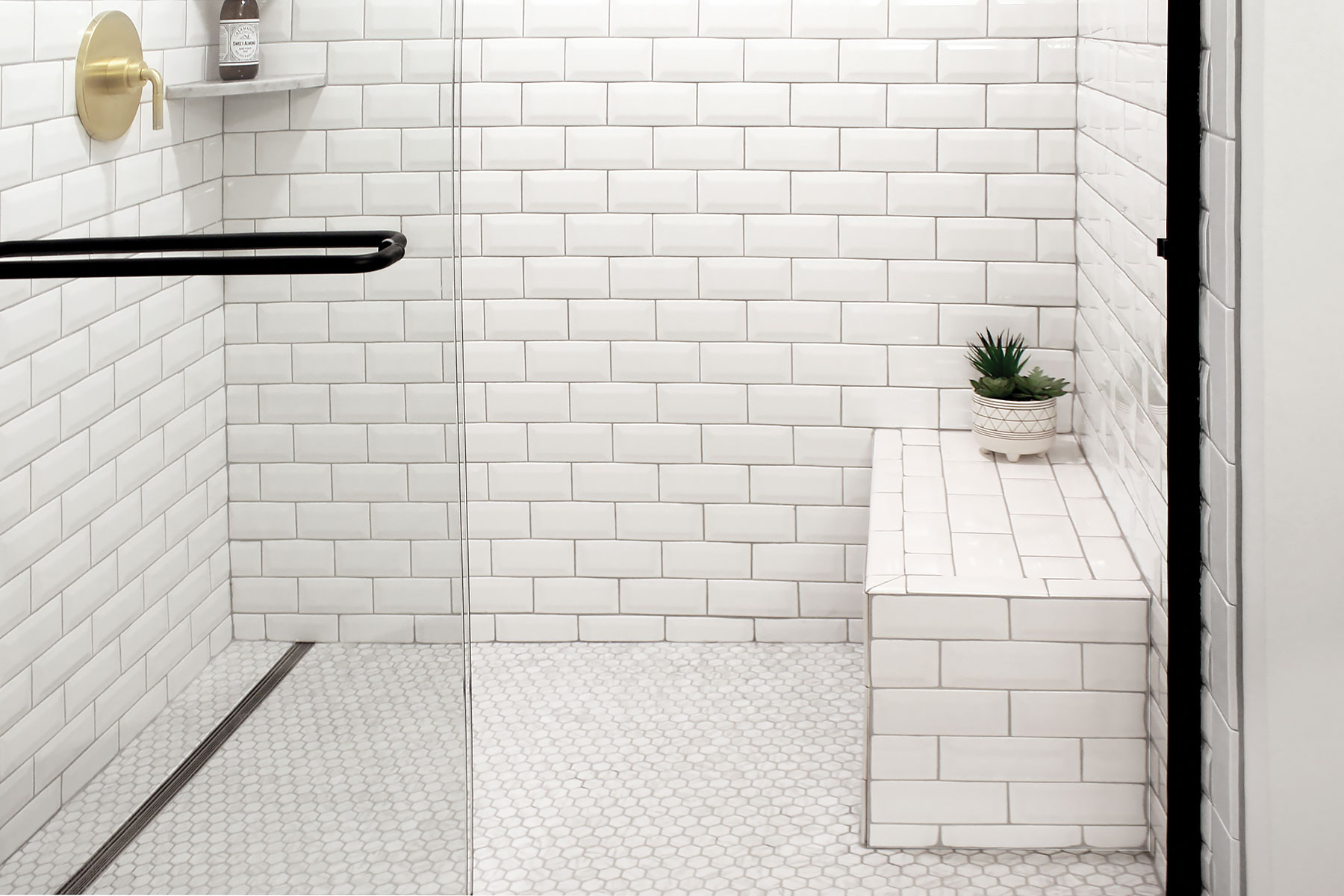
Shower benches like Oatey’s QuickDrain BenchSeat make showering easier and safer for all users. Photo courtesy of Oatey Co.
Shower benches are another great product for universal design, allowing the elderly, users with limited mobility, and the general population at large to have greater control over their personal hygiene. “A shower bench can greatly enhance the look and functionality of a shower. It can serve as a necessary place to sit, a retreat to relaxation, or simply a place to store hygiene products, while also meeting accessibility needs and maintaining style,” writes Novak.
Shower benches like QuickDrain’s BenchSeat can offer accessible design without sacrificing a clean, modern look. The bench accommodates the ADA standards for height and exceeds ADA weight guidelines of 250 pounds. It is also available in three configurations: a rectangle bench and large or small corner bench options. Custom sizes are also available upon request, ensuring consumers have access to the configuration that best meets their needs for accessibility as well aesthetics.
The QuickDrain BenchSeat offers easy assembly and installation. Each bench comes ready to assemble with no framing required, reducing the amount of lumber needed on-site. No mechanical fasteners or anchors are required for installation. The QuickDrain Shower Bench also embraces sustainability, being made with 100% recycled 2-inch rigid PET (polyethylene terephthalate) plastic foam panels. This means that each QuickDrain Shower Bench that is installed uses up to 400 recycled water bottles.
Jessica Powers contributed to this article.

